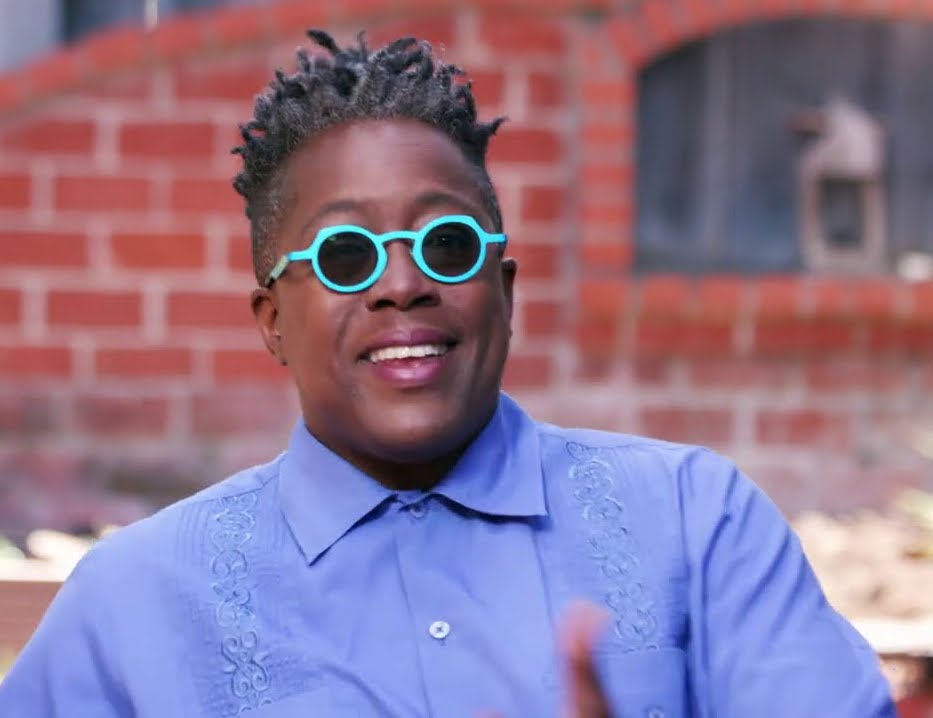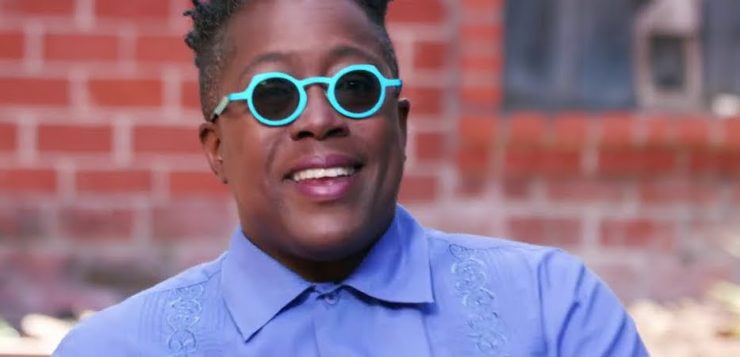LIBERIAN-BORN Cheryl Dunye grew up in Philadelphia, which is where she began her career as a filmmaker, a term that includes directing, producing, and acting in her films. Her first films were a series of shorts about her experience as a Black lesbian, and they combined documentary and narrative elements in what came to be called “Dunyementaries.”
 Dunye’s first feature film, The Watermelon Woman (1996), has been widely recognized as the first feature about African-American lesbians to be directed by a Black lesbian. The film is an example of a Dunyementary in which the director sets out to explore the presence of Black lesbians in early cinema and discovers an actress known as “the Watermelon Woman” who played “mammy” roles in movies of the 1930s. Her next feature film, Stranger Inside (2001), explored a mother-daughter relationship involving two women who are being held in the same prison, and also explored prison conditions and other issues faced by incarcerated women.
Dunye’s first feature film, The Watermelon Woman (1996), has been widely recognized as the first feature about African-American lesbians to be directed by a Black lesbian. The film is an example of a Dunyementary in which the director sets out to explore the presence of Black lesbians in early cinema and discovers an actress known as “the Watermelon Woman” who played “mammy” roles in movies of the 1930s. Her next feature film, Stranger Inside (2001), explored a mother-daughter relationship involving two women who are being held in the same prison, and also explored prison conditions and other issues faced by incarcerated women.
After directing a number of short films, some in collaboration with Sarah Schulman, Dunye started focusing on projects in television rather than film, directing episodes of several series, including Queen Sugar, Sacred Lies, and All Rise. Her most recent project was directing an episode of the six-part TV documentary Pride (2021). She is currently preparing to direct several episodes of the popular Netflix series The Umbrella Academy. In addition to her media career, Dunye is an educator who has taught at UCLA, Pomona College, the New School for Social Research, and San Francisco State, among other institutions.
This interview was conducted by phone in May.
Jen Kamish: I read an interview in which you said you don’t have a coming out story, because you’ve always been open about who you are. Was there never a time when you felt you had to hide your sexuality?
Cheryl Dunye: While I don’t have a specific coming out story, I was never necessarily “in.” I always knew I was a lesbian, gay, and when I got to the point where I needed something beyond the thoughts that were happening in my head, I called the Philadelphia hotline for gay youth. I found out they had a youth group and I showed up for that. It’s very different from what folks experience today.
JK: You’re known for inventing and popularizing an entire genre of film, the “Dunyementary,” which combines elements of narrative and documentary storytelling. What spurred you to create this new style, and which of your works embody it the most?
CD: I think the short film “Janine” was the first time I really sat down with the camera and spoke about my background. I also used elements of Dunyementary in the short film “She Don’t Fade.” Those were some of my early works.
JK: When preparing for Stranger Inside, you conceptualized and ran an interactive theater workshop for incarcerated women. Previous filmmakers’ attempts to work with the inmates had been shot down. What made you decide to use acting as a vehicle for connecting with this population? How effective was it?
CD: So, thank you for asking this question. The process for me—and one that I tried to reproduce in other films—was like writing a thesis. I was inspired by Angela Davis with her prison industrial complex conferences and when she hit the Claremont Colleges, where I was teaching at the time.
I already had a grain of a concept and had been thinking about what women inmates experience in prison. I was trying to put myself in the shoes of somebody who was in that situation, having personally only been arrested for protesting. How did my experience relate? How was it different?
Living in Pasadena, I have my son, who is white, and my daughter, who is Black. One day, I was pushing the stroller around and this woman started looking at me. She came up and said, “Oh, you must be a really good nanny! How much does it cost to hire you?” That experience there? That created a little fire. A little fire had to go into making this, too. It kind of kicked things to the next level. I had to consider: what is mothering? What is the Black experience of mothering? That was something I wanted to dip into. I was inspired to push some of these bigger questions. So, that’s where it began.
And then, after that, I tried to find the text. When finding the text, I really had to think about what is the real story here? What is the real nonfiction story where inmates have a dialogue—just a simple dialogue? Luckily, I had Sheryl Mousley, who I knew from the Walker Art Center [where she did a residency and screened The Watermelon Woman].
I also do a lot of research, and I began looking at a women’s correctional facility, one that had no fence and that was sort of “liberal.” So, I went there and did a survey, and they had great stories. And so that’s where the majority of my data came from—the Minnesota Correctional Facility for Women in Shakopee, Minnesota. I got a script written and then, in exchange, I tried to make the experience beneficial for the women as well. I never take without giving.
JK: While your work spans several genres and offers insightful commentary on everything from race, gender, and sexuality to relationships both familial and romantic, what critical issues do you feel are still not being talked about in mainstream media?
CD: There are still not enough stories about Black queer women. It’s not what’s being focused on in the media, and the stories that are told are produced and directed by everyone except Black queer women. We have yet to see a film that has been developed solely by Black queer women at every level. I am also looking for moments when we deal with the international aspect of Black womanhood. We have not had enough of these films. I’d love to see more intersectionality in all of these areas.
JK: As a professor, you regularly work with young, motivated individuals who want to be involved in social issues but might not know where to start. What advice would you give to “armchair activists” who would like to take a more hands-on role in effecting change?
CD: We keep the art and the activism on the ground separate, and we need to change that. Young people could definitely get more involved in collaboration. Collaborate. Show up and speak up. Take on a role in whatever you’re interested in or passionate about. Whatever you’re doing, show up. Network. Keep going to the places where you think you should be and make sure you connect with them. Find somebody’s name and keep showing up. That’s number one.
Number two is that everybody thinks they have to do everything, but filmmaking and writing and every kind of art involve a lot of collaboration, so it’s okay if you can only do one piece of something—practice that. Let go of the need to control each section of a project. Let go of the control you feel you need around you. Connect with people who do the things you want to do and work with them. Build a community. Communities change the world.
JK: Over the last few years, your career has pivoted from a primary focus on film to episodic television. What prompted this shift, and how does working in the two industries compare?
CD: With film you really have to wait so long for something to come to fruition. That was the big thing for me. When you’re working on a project as a producer and filmmaker, you’re waiting a year to get your scripts and stuff approved and then another year for funding, and then you have this window in which you need to get everything done. And at the end of all this, you have to sell it, and if it doesn’t sell, you’re back at the starting line and that’s five or six years of your life.
So, when I was tapped by the wonderful Ava DuVernay to direct Queen Sugar, I was at the point where I was so tired of waiting on the film projects. I had ideas and a style of filmmaking that needed to be brought to light sooner than it was happening in the film industry.
JK: Many of your popular works—such as The Watermelon Woman and Stranger Inside—involve a substantial archival process. What kinds of research do you typically do before beginning a project?
CD: When I get an idea, the first thing I do is to look at the historical timeline as well as the cultural context around it: what was happening at the time? Even though we have the Internet, I often do this in the library. I like libraries. I go to libraries, because what you get in a library is protected. You might be looking for one thing and find a book on the other side of the aisle that might have some relevance. You take all these things home with you. Every time I walk through the library, I feel like the stories are screaming.
I usually spend about a year in research. I’m rumbling with the information and reshaping it. I got my MFA at Rutgers and I studied with painters and sculptors. I was doing video, and you see this with every type of art: people are working in their studios, creating something, and I was really into that.
JK: How do you envision your legacy? What do you hope people will be saying about you fifty years from now?
CD: I hope that my legacy is one of completion. That I completed everything I set out to do. That I practiced what I preached. That I figured out what my work was, and did it, and it reflected the concept of who I am. And that things I’ve worked on all my life are carried out—like Gilda Stories. I’ve wanted to do it for a long time, and it’s going to happen.
JK: Finally, what is your favorite song to sing in the car?
CD: One of my favorite karaoke songs is True by Spandau Ballet. However, as I speak I’m here in lovely Toronto, which is in Covid isolation.
Jen Kamish, EdD, is an educator, writer, and travel enthusiast based in Rochester, NY.







Discussion1 Comment
Miss duane i saw the watetmelon women it was very. Awesome.i am looking forward to seeing more of your films in the future .